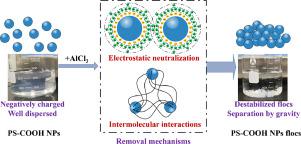Water Research ( IF 11.4 ) Pub Date : 2021-11-21 , DOI: 10.1016/j.watres.2021.117884 Yanyan Gong 1 , Yang Bai 1 , Dongye Zhao 2 , Qilin Wang 3

|
Nanoplastics (NPs) pollution of aquatic systems is becoming an emerging environmental issue due to their stable structure, high mobility, and easy interactions with ambient contaminants. Effective removal technologies are urgently needed to mitigate their toxic effects. In this study, we systematically investigated the removal effectiveness and mechanisms of a commonly detected nanoplastics, carboxyl-modified polystyrene (PS-COOH) via coagulation and sedimentation processes using aluminum chloride (AlCl3) as a coagulant. PS-COOH appeared as clearly defined and discrete spherical nanoparticles in water with a hydrodynamic diameter of 50 nm. The addition of 10 mg/L AlCl3 compressed and even destroyed the negatively charged PS-COOH surface layer, decreased the energy barrier, and efficiently removed 96.6% of 50 mg/L PS-COOH. The dominant removal mechanisms included electrostatic adsorption and intermolecular interactions. Increasing the pH from 3.5 to 8.5 sharply enhanced the PS-COOH removal, whereas significant loss was observed at pH 10.0. High temperature (23 °C) favored the removal of PS-COOH compared to lower temperature (4 °C). High PS-COOH removal efficiency was observed over the salinity range of 0−35‰. The presence of positively charged Al2O3 did not affect the PS-COOH removal, while negatively charged SiO2 reduced the PS-COOH removal from 96.6% to 93.2%. Moreover, the coagulation and sedimentation process efficiently removed 90.2% of 50 mg/L PS-COOH in real surface water even though it was rich in inorganic ions and total organic carbon. The fast and efficient capture of PS-COOH by AlCl3 via a simple coagulation and sedimentation process provides a new insight for the treatment of NPs from aqueous environment.
中文翻译:

羧基改性聚苯乙烯纳米塑料在水中与氯化铝的聚集:结构表征和理论计算
纳米塑料 (NPs) 对水生系统的污染正成为一个新兴的环境问题,因为它们结构稳定、流动性高且易于与环境污染物相互作用。迫切需要有效的去除技术来减轻它们的毒性作用。在这项研究中,我们通过使用氯化铝 (AlCl 3 ) 作为混凝剂的混凝和沉降过程系统地研究了一种常见的纳米塑料、羧基改性聚苯乙烯 (PS-COOH) 的去除效果和机制。PS-COOH 在水中表现为明确定义的离散球形纳米粒子,流体动力学直径为 50 nm。添加 10 mg/L AlCl 3压缩甚至破坏了带负电荷的 PS-COOH 表面层,降低了能垒,并有效去除了 96.6% 的 50 mg/L PS-COOH。主要的去除机制包括静电吸附和分子间相互作用。将 pH 从 3.5 增加到 8.5 会显着提高 PS-COOH 的去除率,而在 pH 10.0 时观察到显着损失。与较低温度 (4 °C) 相比,高温 (23 °C) 有利于去除 PS-COOH。在 0-35‰ 的盐度范围内观察到高 PS-COOH 去除效率。带正电的 Al 2 O 3的存在不影响 PS-COOH 的去除,而带负电的 SiO 2PS-COOH 去除率从 96.6% 减少到 93.2%。此外,即使实际地表水中富含无机离子和总有机碳,混凝沉淀过程也能有效去除 90.2% 的 50 mg/L PS-COOH。AlCl 3通过简单的混凝和沉淀过程快速有效地捕获 PS-COOH,为处理来自水环境中的 NPs 提供了新的见解。









































 京公网安备 11010802027423号
京公网安备 11010802027423号